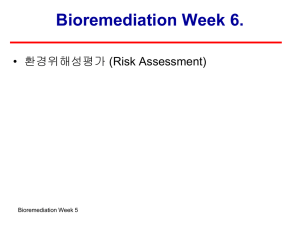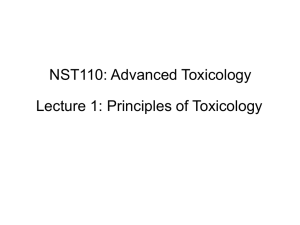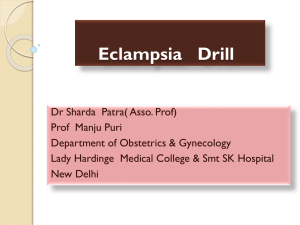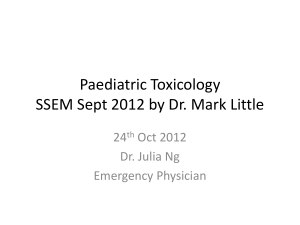Environmental Health, Pollution, and Toxicology EXAM
advertisement
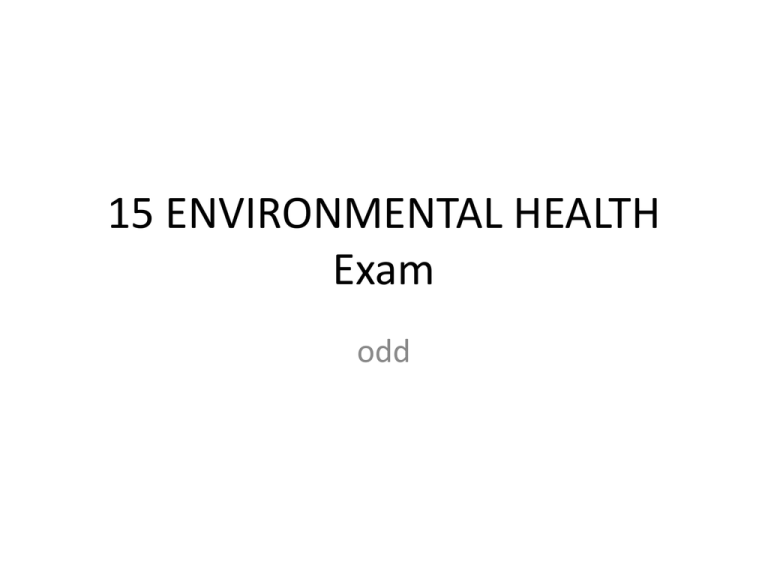
15 ENVIRONMENTAL HEALTH Exam odd 1. The interaction of different substances where the combined effect is greater than the sum of the effect of the separate substances: • • • • • dose response synergism particulates threshold biomagnification A) B) C) D) E) 2. Which of the following terms refers to the principle that the effect of a certain chemical on an individual depends on the concentration of this chemical: A) B) C) D) E) dose response synergism particulates threshold biomagnification 3. • • • • • Anthropogenic sources of radiation include medical and dental x-rays, nuclear weapons tests, and nuclear power plants. A natural source of radiation is/are: A) the Sun B) granite bedrock C) natural radioisotopes in the soil and atmosphere D) all of these E) none of these – all radiation in the environment is caused by humans 4. • • • • • Fungicides are: A) chemicals to control weeds B) chemicals to control insect pests C) chemicals to control fungal plant diseases D) fungal plant diseases E) any variety of fungus that attacks livestock or humans 5. A carcinogen is a particular kind of: I. therapy to treat cancer II. toxin that may cause cancer III. pollutant that affects the DNA • • • • • A) B) C) D) E) I only II only III only II and III I and III 6. • • • • "Body burden" refers to the: A) ability of the body to reproduce B) development of cancer C) how much weight a person can carry D) body's ability to develop a physiological tolerance to toxins • E) accumulation of heavy metals in the body 7. What is the major source of chronic heat pollution in water systems? • • • • • electric power plants petroleum refineries geothermal power volcanic eruptions friction A) B) C) D) E) 8. Noise pollution (sound) is measured in units of decibels (dB), which are each one-tenth of a bel. How much louder is 50 dB than 30 dB? A) B) C) D) E) about 1.67 times 2 times 20 times 100 times 220 times 9. The term "ideal pesticide" refers to: • A) a chemical that harms nothing in the environment • B) a pesticide that is active only briefly and then degrades into harmless substances • C) a chemical that kills all varieties of pests that threaten a crop • D) a pesticide that needs to be applied only once • E) a chemical that affects only one pest and no other living thing or aspect of the environment 10. Which of the following examples is not a pollution point source: • A) contamination of groundwater from a solid waste landfill • B) air pollution from the smoke stack of a large chemical plant • C) chemicals leaked into a stream from an accidental spill • D) air pollution from automobile exhaust • E) water pollution from an oil refinery 11. 100 ppm (100 mg/kg) is equal to 0.01%. How many ppm is equal to 1% • • • • • A) B) C) D) E) 1 mg/kg 100 mg/kg 10,000 mg/kg 1,000,000 mg/kg 100,000,000 mg/kg 12. Why do small plants with a relatively short life time cope with pollution better than larger plants with a longer span? • A) smaller biomass accumulates smaller quantities of pollutants • B) they develop immunity • C) they are exposed to less polluted air • D) they are better able to develop a tolerance over multiple generations • E) the adaptation rate of these plants is much smaller than of plants with a long lifetime 13. Point C is a significant threshold. What does point C signify? • • • • • A) maximum benefit B) harm exceeds benefits C) death of 50% of a test population D) first measurable effects E) death of 100% of a test population 14. Major concepts in evaluating and treating the effects of environmental pollutants include all of the following except: • A) individuals vary in their response to exposure to the same dose of a pollutant • B) some pollutants have minimum thresholds • C) effects of environmental toxins are nonreversible • D) the chemical form of the pollutant has a great effect on its toxicity • E) the pollutant and its activity are changed by ecological and biological processes 15. The lessons learned from the pollution episode at Minamata, Japan include all of the following except: • A) pollutants can be chemically transformed in the environment into more toxic forms • B) DDT can cause damage to the environment that may last for decades • C) humans are themselves susceptible to toxic pollutants • D) toxic pollutants may be naturally concentrated through the process of biomagnification • E) a pollution problem may be slow to be recognized, admitted, and remedied 16. Once absorbed, some toxic compounds are retained in the tissue of various life forms for long periods of time. These pollutants pose special risks to humans and other organisms high on the food chain through the process of: • • • • • carcinogenesis compound contamination synergism threshold effect biomagnification A) B) C) D) E) 17. If the curve indicates the effects of an agricultural pesticide on a severe pest, what is the maximum dose a farmer should apply to his crop? • • • • • A) B) C) D) E) dose 1 dose 2 dose 3 dose 4 dose 5 18. If the curve represents the incidental mortality of apple trees after spraying of a pesticide to control apple weevils, what is the largest dose that an apple grower should choose? • • • • • A) B) C) D) E) dose 1 dose 2 dose 3 dose 4 dose 5 19. In the figure above, what does point C signify? The dose above which harm exceeds benefits 20. If the above curve were for the effects of fluoride on humans, what dose should a dentist recommend to his patient? He should recommend dose 2 21. Dose 2 is known as: • minimum threshold dose 22. If the curve shown above represented the effects of an agricultural pesticide on a severe pest, what is the maximum dose a farmer should apply to his crop? Dose 4 23. How would an increasing tolerance in the pests to this chemical affect the position of the curve? It would shift curve to the right or down 24. Distinguish between environmentally benign and hazardous organic compounds. Benign organic compounds are produced by living organisms. Artificially organic compounds are usually environmentally hazardous. Some organic compounds are more hazardous than others. Fat-soluble compounds are likely to undergo biomagnification and degrade fast. Some organic compounds that are of serious concern are pesticides, herbicides and dioxin. 25. Arsenic was one of the first pesticides used on potatoes, cotton and apples. Why is this pesticide not ideal for the whole environment? It is a highly toxic substance that affects virtually all forms of life, including humans. 26. List three major effects of lead poisoning. 1. Stillbirth 2. Deformities 3. brain damage 27. Name four of six major categories of environmental pollutants listed in the textbook. List four of the following: • toxic chemical compounds • radioisotopes • organic compounds • heat • particulates • noise 28. What is genetic tolerance? Give an example. • Genetic tolerance is adaptation to the environment. It results when those individuals who are most resistant survive an exposure to a toxin and have more offspring than the others. Insects become resistant to pesticides.







